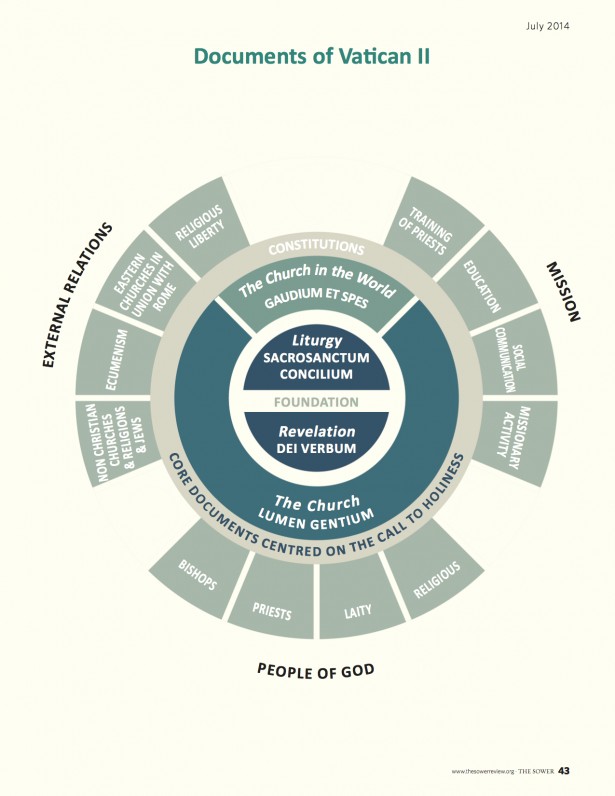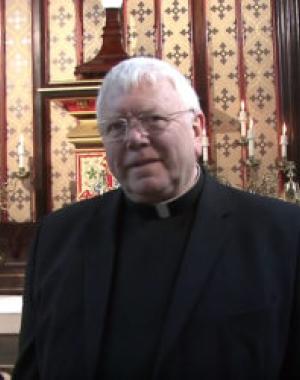The Second Vatican Council took place in Rome during three autumnal sessions between 1963 and 1965. The outcome of the Council was a set of sixteen documents that are the result of the deliberations of the Bishops in union with the Pope. Pope John Paul II described the Council as “a providential event” that has made “a significant contribution to the… new springtime of Christian life…if Christians are docile to the action of the Holy Spirit.”[i] Many requests have been made by our readers for this article and organizational chart of the documents of Vatican II to be reprinted. The editorial staff of The Sower is happy to make this available once more.
In preparing for the Great Jubilee and new Millennium, the Pope called for an examination of conscience on the part of Catholics. One element of this was to consider “the reception given to the Council, this great gift of the Spirit to the Church.”[ii] Perhaps the Pope had a sense that, nearly forty years after the Council, there were still a great many in the church who did not really know what the Council achieved and taught.
It is time now for a return to the documents of the Council. So often we have received teaching about the Council in a second-hand way. We feel that we may not be sufficiently equipped to read the texts of the documents ourselves. The truth is that it is always good to go to the sources. In the past some held the same view about the Sacred Scriptures. However, today many are reading the Scriptures and finding great nourishment from them. Similarly, in the Catechism many are finding that their minds are being opened to the riches and the wonderful harmony of the Catholic faith.
In order to properly understand the scope of the Council, it would be perhaps helpful to see an overview of the way that the documents fit together and relate to one another. There is a logical structure and order to the sixteen documents. A first step might be to get an insight into this structure in order to “see the wood for the trees”.
Structure
The notion that there is a logical structure and coherence to the documents is first hinted at by the descriptions given to the various documents. Each document is described in one of three ways: as a constitution, a decree or a declaration. These three titles differentiate the relative significance of each document and the relationships between them. The more foundational constitutions and the more specific decrees give us a deeper understanding the mystery of Christ and his Church, while the declarations speak directly to all people of the world.
The central document and key to all of the teachings of the Vatican Council is the Dogmatic Constitution on the Church. At the heart of this teaching is the vision of the Church as a Sacrament. The church is the sacramental presence of Christ and his saving work in the midst of the world. This sacramental nature comes about through union with Christ established principally in the Sacrament of Baptism. This union matures through growth in holiness. The universal call to holiness is the central concept of the whole document. Christ continues his saving work—the work of redemption—through the action of the Church today! This can happen because Christ has united himself to those who are his followers and through the gift of the Holy Spirit, has ensured that the life and activities of the Church and its members continue to make him present in the world.
The Pastoral Constitution on the Church in the Modern World develops the more general teaching on the nature of humanity and of human society and the urgent question and problems of the day.
You will see from the diagram that those documents that are described as constitutions form the central teaching of the Vatican Council. Two of these—the Constitution on the Sacred Liturgy and the Constitution on Divine Revelation—can be described as foundational. Along with the two constitutions on the Church, they form the heart of the council’s teaching on the mystery of the Church. Divine Revelation is the source of the Church’s life and teaching. The Liturgy is both the place where the Church most clearly expresses and communicates what she is and at the same time where she draws nourishment for her mission from the Paschal Mystery she celebrates.
The remaining twelve documents can be grouped into three sets. One set will expand the Dogmatic Constitution on the Church from the point of view of its structure and membership—Bishops, Laity, Priest, and Religious. Another set will expand the constitution in relation to the Church’s mission in the world—Missionary Activity, Training Priests, Social Communication and Christian Education. The third set of three will describe the Church’s relations with the world religions—the Eastern Church, other Christian Churches, the other World Religions including the Jewish Faith and the Declaration on Religious Liberty.
The documents of the council have a shape and structure. The diagram is offered to help you understand this shape and the way that the various documents relate to one another and to the central Constitutions.
© The Sower January 2002 and July 2014 issues.
Notes
[i] John Paul II, Tertio Millennio Adveniente, no. 18.
[ii] Ibid., no. 36.
This article was originally on pages 42-43 of the printed edition.

This article is from The Sower and may be copied for catechetical purposes only. It may not be reprinted in another published work without the permission of Maryvale Institute. Contact [email protected]


















